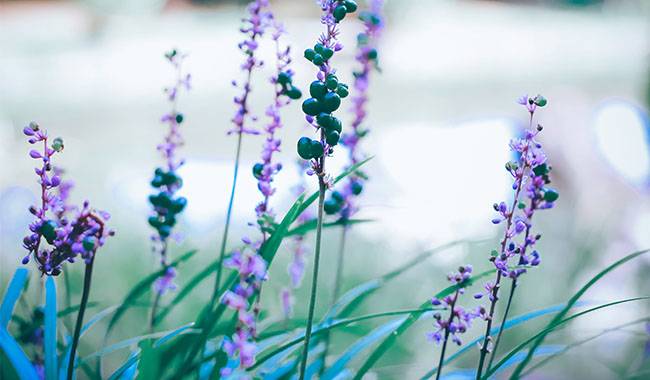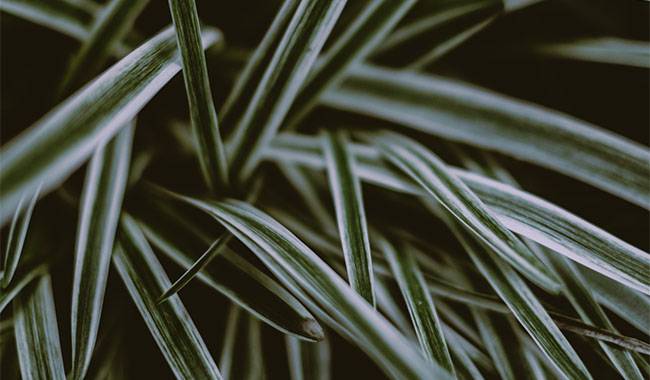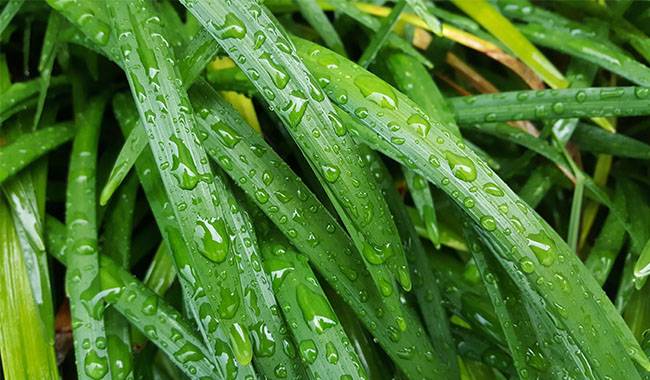
Few evergreen perennials can compete with the Ophiopogon plant, planted in a garden or as a house plant. The distinctive texture of its broad metallic leaves gives its dense turf such a unique appearance that it is often mistaken for a cereal. But even more striking is its flowering, which is why it is known as the Japanese Lily of the Valley. The moving bunches of inflorescences and more vibrant fruit look quite exotic. However, it is not an easy plant to grow and has many requirements for conditions and care. You will learn how to grow Ophiopogon plants in ThumbGarden’s article.
OPHIOPOGON PLANT DESCRIPTION
Its ornamental grass-like appearance often leads to comparisons with herbaceous plants, although this plant is quite different in every way. Although the texture and effect of the garden ophiopogon’s neat, fountain-like, fur-like turf are misleading, it is capable of surprising almost any feature.
Ophiopogon is an evergreen tropical perennial that belongs to the Asparagaceae family. It has a strong but short compound rhizome, with short rhizomes intertwined with slender adventitious roots.
Ophiopogon produces dense and lush rhizomatous tufts of leaves – narrow, linear, blunt-edged, arching or lobed, strap-like, or grass-like. Up to 20 inches (50 cm) long on houseplants and 35 inches (90 cm) long on garden plants, they are only 7 to 12 mm wide.
The color of the leaves is worth seeing, as even green ophiopogonas are colorful, with interesting shades and metallic colors, and there are striped, mottled, or fuchsia plants in the species.
Ophiopogon’s flowering period traditionally spans July and August but often varies depending on conditions. It is no accident that it has been compared to the lily of the valley. On stout, thickened fleshy inflorescences much shorter than the leaves, the inflorescences open in clusters, neatly shaped up to 6 inches (15 cm) long, in which each flower is clearly visible. It forms a short tube at the base, and forked lobes flank the perianth at the apex. ophiopogon is lilac-pink, purple, and sometimes white. The stamens are very short, totaling six.
After flowering, three nests of ovaries develop. The unbranched berry-like fruit, usually tinted blue or purple, looks very bright.
SPECIES OF OPHIOPOGON INDOORS
Although Ophiopogon is still more of a dream to use in our gardens, available in southern areas and mild subtropical or tropical climates, indoor Ophiopogon is becoming more and more popular. Ophiopogon is more valued for its variegated varieties and species, and indoor ones are preferred for the simplest monochromatic variants.
Only two species of ophiopogon can be grown as potted plants.
Ophiopogon jaburan or white Ophiopogon jaburan forms entire stolons, dense bushes adorned with broad, leathery, strap-like leaves. Its lavender or white racemes alternate with dazzling blue-violet fruits. The compact, specially bred varieties, most often with broad leaves and stripes, are slow-growing, low-growing plants in its indoor form. The name usually indicates the main characteristic of the variety (“Silver Dragon,” “Compactus”), but more often, the plants are nameless.
Ophiopogon japonicus is a rhizomatous, more ornamental species with narrow, dark, often almost inky leaves up to 15 inches (40 cm) long, with very short white or lavender racemes and almost black, bluish berries. The room is also represented by unnamed species with a height of 4-10 inches (10-25 cm).
SPECIES OF OPHIOPOGON INDOORS

Although Ophiopogon is still more of a dream to use in our gardens, available in southern areas and mild subtropical or tropical climates, indoor Ophiopogon is becoming more and more popular. Ophiopogon is more valued for its variegated varieties and species, and indoor ones are preferred for the simplest monochromatic variants.
Only two species of ophiopogon can be grown as potted plants.
Ophiopogon jaburan or white Ophiopogon jaburan forms entire stolons, dense bushes adorned with broad, leathery, strap-like leaves. Its lavender or white racemes alternate with dazzling blue-violet fruits. The compact, specially bred varieties, most often with broad leaves and stripes, are slow-growing, low-growing plants in its indoor form. The name usually indicates the main characteristic of the variety (“Silver Dragon,” “Compactus”), but more often, the plants are nameless.
Ophiopogon japonicus is a rhizomatous, more ornamental species with narrow, dark, often almost inky leaves up to 15 inches (40 cm) long, with very short white or lavender racemes and almost black, bluish berries. The room is also represented by unnamed species with a height of 4-10 inches (10-25 cm).
GROWING CONDITIONS OF OPHIOPOGON INDOORS
Ophiopogon prefers cooler conditions and will not flower in winter without cooler temperatures (and will get sick more often, age, and degenerate faster). For overwintering, it is sufficient to find a place with cool temperatures of at least 59 °F (15°C) or so, but of course, a cooler room will allow the plant to flower more vigorously – preferably between 41-50 °F (5-10°C). The plant will survive the warm winter as long as the air humidity is raised.
Ophiopogon can best be protected from high temperatures by choosing a room temperature that does not exceed 77 °F (25 °C) or by moving it outside in the summer. During active vegetation, the minimum allowable temperature is 64 °F (18 °C). If Ophiopogon is placed in a cool foyer or hall, lobby, or climate-controlled room, its humidity-loving nature will be greatly reduced.
This is a crop that prefers a halfway house and should be assigned a spot in the room on the northern or eastern windowsill, at a distance from the western and southern windows (where they will be too hot on the sill and direct sunlight will damage the leaves).
The species can also tolerate greater shade as long as it doesn’t have too many stray colors and no abnormal shade. In winter, the plant does not need to be moved, but only if the ophiopogon is in a cool place: if the winter is warm, the light should be increased.
ophiopogon is a plant with a distinctly oriental character, even when cultivated indoors. It looks great in Japanese and Chinese interior styles or with minimalist and high-tech elements in modern environments.
It is best to bring ophiopogon outside into the fresh air from mid-spring to late summer. The plant is not afraid of drafts and tolerates temperature fluctuations very well.
CARE OF OPHIOPOGON IN HOME CONDITIONS

Ophiopogon prefers stable moist soil. They have a poor tolerance for dry and wet substrates in the room. To avoid the risk of overwatering, it is important to drain the tray immediately after watering and keep the top few inches of soil dry. Over-watering and over-watering will quickly lead to root rot.
In winter, the soil should dry out a little deeper. Use standing water or soft water for ophiopogon.
The need for higher humidity depends directly on the temperature. In cool conditions, ophiopogon can tolerate living room conditions. If the temperature exceeds 68 °F (20 °C), it needs to be moderate. In high temperatures – the humidity is very high. Spraying can be done only by spraying, but it is better to limit it to installing humidifiers (industrial or at least trays with wet pebbles).
Fertilize only during active vegetation – from mid-spring to the end of summer, stopping as the vegetation fades. Ophiopogon can be fertilized with a standard compound fertilizer and with a classic frequency (every 2-3 weeks).
Remove dry leaves every so often, all the way to the bottom.
TRANSPLANTING, CONTAINERS, AND SUBSTRATES
The most common practice for resetting Ophiopogon is to remove the dry part of the turf every year, but resetting can be postponed if the plants are slow to develop. This process is best done only at the beginning of growth, but ophiopogon can be separated throughout the active vegetation period if air humidity increases. ophiopogon requires wide, squat, low pots.
Ophiopogon can be grown as a single plant or mixed with other light-loving plants in large containers. It is actively used in greenhouses and their replicas, complex indoor garden variants, and sophisticated office landscaping.
A light, neutral, or slightly alkaline substrate containing perlite or other loosening agents should be selected for this plant. A general-purpose soil without peat is fine to which any additional loosening agent is added. The drainage layer should be at least 2 inches (5 cm). Mulching of the substrate is encouraged.
Ophiopogon grows well in hydroponic and alternative substrates, including coconut fiber.
DISEASES, PESTS, AND GROWTH PROBLEMS
Any lapse in care can have a direct impact on the foliage. Errors in watering (in either direction) can be easily identified by errors in leaf spotting, light, and temperature – by the growth rate, the color of the green plant.
If watered excessively, this plant is susceptible to decay, and even a single water accumulation in the tray may be enough. Pests are not uncommon in ophiopogonas in the room. Spider mites are not easily eliminated from lush turf, and Ophiopogon can rapidly reduce plant growth. These insects should be treated immediately with insecticides.
PROPAGATION OF OPHIOPOGON
Indoor Ophiopogon can be divided into not-so-small parts when transplanted.
The seeds of the plant used for sowing must be freshly picked. They are rarely seen on the market, and asexual propagation is preferable because the waiting time is shorter, and maximum ornamental effect can be achieved. In early spring, sow ophiopogon shallowly in containers, keeping them moderately warm. Plants should only be picked when at least a small bunch of leaves has formed, so it is best to sow them sparsely.







